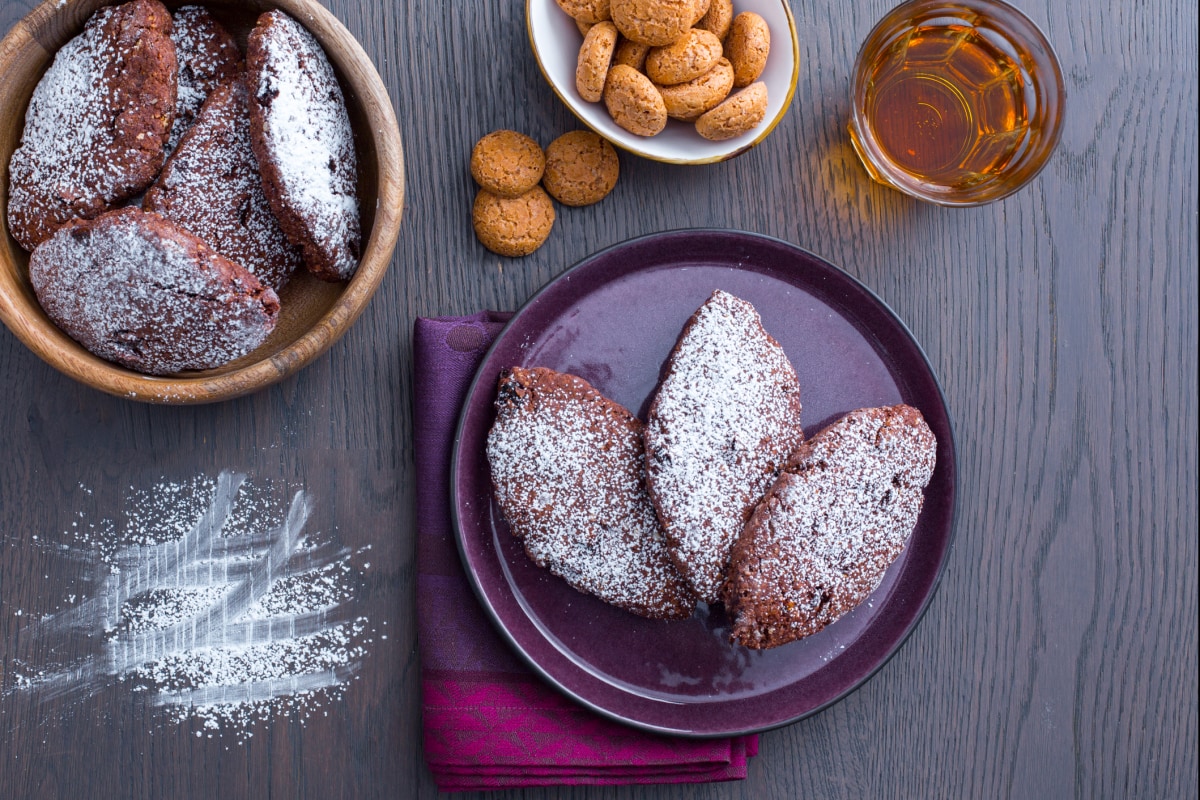Pan dei Morti (Bread of the Dead)

- Vegetarian
- Energy Kcal 760
- Carbohydrates g 131.9
- of which sugars g 89.2
- Protein g 17
- Fats g 17.2
- of which saturated fat g 3.64
- Fiber g 9
- Cholesterol mg 108
- Sodium mg 193
- Difficulty: Easy
- Prep time: 30 min
- Cook time: 30 min
- Makes: 16 pieces
- Cost: High
- Note it is recommended to consume at least 2 days after baking
PRESENTATION
Traditional sweets to celebrate All Souls' Day and All Saints: pan dei morti (bread of the dead), an ancient recipe originating from Milan and spread in various areas of Northern Italy, with slight differences in dough and shape of these dense, pasty, and very tasty cookies. Almonds and dried figs, pine nuts, raisins, and rum, cocoa... are some of the elements that make bread of the dead characteristic and special, in addition to its slightly flattened oval shape, dusted with powdered sugar. A true delight to celebrate this tradition, which in Italy knows no boundaries: in Tuscany, bread of the dead is also prepared, while in Umbria the beans or the bones of the dead are commonly consumed, in Sicily the Rame di Napoli, while in Naples the typical torrone!
INGREDIENTS
- Ingredients for about 16 pieces
- Type 00 flour 2 cups (250 g)
- Cookies 3.5 oz (100 g)
- Amaretti cookies 3.5 oz (100 g)
- Ladyfingers 3 cups (300 g)
- Sugar 1 ½ cup (300 g)
- Unsweetened cocoa powder 10 tbsp (50 g)
- Almonds ¾ cup (120 g)
- Dried figs 4.25 oz (120 g)
- Raisins 0.8 cup (120 g)
- Egg whites 6 - (of medium eggs)
- Vin santo wine 3.5 oz (100 ml)
- Cinnamon powder 1 tsp
- Nutmeg to taste - to grate
- Baking powder 2 tsp (10 g)
- for dusting
- Powdered sugar to taste
How to prepare Pan dei Morti (Bread of the Dead)

To prepare the bread of the dead, start by rinsing and soaking the raisins in a small bowl with water (alternatively, you can soak them directly in the vin santo from the recipe) 1. In the cup of a blender, add the dry cookies, amaretti, and (if sufficiently powerful) also savoiardi: if they don't fit, you can do it a bit at a time 2. Blend until you obtain very fine crumbs and transfer the mixture to a large bowl 3.

Now, put the almonds in the same blender and grind them into flour 4, then add them to the crushed cookies. Now, also process the dried figs in the blender and add them to the bowl 5. Mix in the granulated sugar 6,

the flour 7, the cocoa 8, a pinch of nutmeg, and the cinnamon. At this point, drain and squeeze the raisins well before adding them to the mixture 9,

add the sifted baking powder 10, the vin santo 11, and the egg whites 12.

Start combining all the ingredients with your hands or, if you prefer, use a spatula or a wooden spoon 13, and when the mixture is sufficiently compact, transfer it to a lightly floured work surface and knead it with your hands until you obtain a homogeneous and fairly firm dough. Form a loaf 14 and cut into slices of 3-3.5 oz each 15.

Shape the pieces into a low form about ½ inch thick, making them elongated about 5-6 inches long and 2-2½ inches wide 16. Try not to add flour during this phase. Cover a baking sheet or pan with parchment paper and arrange your bread of the dead on it, spacing them a few inches apart 17, as they will expand slightly during baking. Bake the cookies in a preheated oven at 355°F for about 25 minutes, then remove them, dust with powdered sugar 18, and let them cool. Serve the bread of the dead only after allowing it to rest for at least two days to let it soften properly.